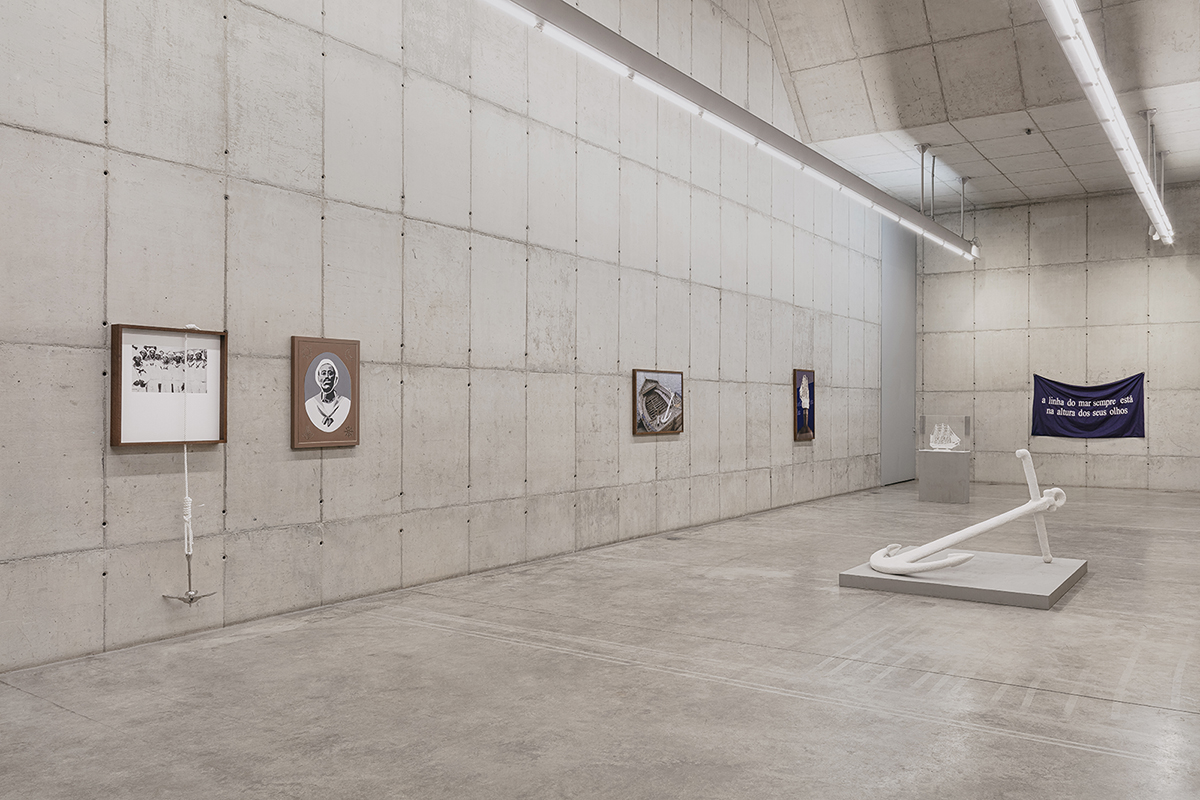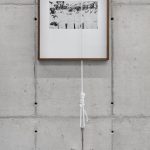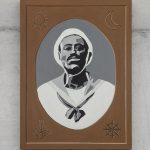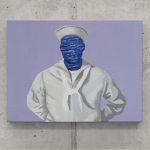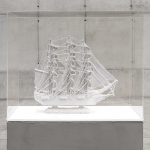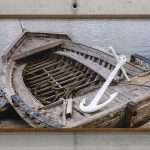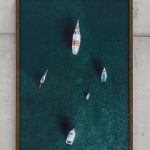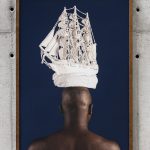Irmãos de Barco
by Moacir dos Anjos
Tiago Sant’Ana has already been building work that ties art and history in a short yet very dense trajectory, creating newfound knowledge about facts that are supposedly already established. He suggests inflexions into leading narratives about Brazil’s colonial past, using a wide field of ideas to create performances, photography, video, sculpture, drawing, installation and painting. He digs into descriptions and explanations consecrated in the past, situations and subjects that have been pushed to the margins of society or even made invisible; inscribing on the dominant conversations, the violence associated with the slavery of bodies in modern world constitutions. Using his perspective as a Brazilian black male, Sant’Ana proposes new convergences between happening and people, between cause and effect, between what has happened and what is happening. For this, he elects objects and topics that articulate aesthetic and ethical thinking, seeing as any accurate representation implicates exclusions from ways to situate ourselves in life; it implies confirmation of consensus or opening of fractures in the conventions that regulate how bodies are distributed in private and public spaces.
In his previous works, the artist has used day-to-day objects- like shoes- as examples of historical processes that erased enslaved black people or their community affirmation when freed from this form of brutal subjugation workforce. The exhibition here presented takes the Atlantic crossing from countries in Africa to Brazil – a route that confirmed the domination of black bodies to Portugal’s political and economic cause -as a starting point for its dialogue. It examines this oceanic transit covered in pain and translates it into a sensitive conversation that offers distinct ways of confronting violence that has yet to cease today. This compilation of diverse works all uses as a symbolic or constructive tie, sugar, food and export products that established Brazil’s colonial enterprise during the sixteenth century. This product made it possible for continuous traffic of imprisoned black people from different points in Africa to be enslaved on the other side of the Atlantic.
*
Looking to meet Europe’s growing consumer market, sugar cane production gradually took on a central role in Brazil’s colonial economy, moulding social relations and the country’s culture. This expansion reached wide and far, making it to Brazil’s borders. The most significant sugar cane production happened in Pernambuco and Bahia, where Tiago Sant’Ana is himself from. Towards the end of the 16th Century, there was almost one-hundred and fifty sugar cane plantations working in Brazil, all conceding Portugal its international monopoly over the product. Such growth requires a constant increase in the labour force, which can only be satisfied at first, with the slavery of indigenous people, and later with the influx of African men and women brought to Brazil. From this point onwards, and until half of the 19th century, Portuguese vessels made almost fifteen thousand oceany travels to transport people from African to Brazilian territory, carrying nearly 4,8 million people who had been stolen from their families’ arms their homes to be enslaved.
This irreparable loss, made irreversible during the trip, is summarised by the artist in the photograph “Fluxo e refluxo” [Flow and reflux]. In it, we can see a black man – bare-chested and facing backwards to the camera that photographs him – carrying, o his head, a miniature replica of a white ship made entirely of sugar. The bow of the boat points to one direction – historically, to its destination, the slave colony and exporter – while the man faces the opposite direction – towards the native land of all the enslaved men and women that he represents; a place to which once they have left they will never be able to return -. Besides the physical distancing, the colonial enterprise forced a relocation that makes it impossible to return home. The desire to return understood as the desire to have some footing of memory of your place of origin, is permanently aggravated in the context of the diaspora. Once arriving onto slave colony territory, they were forced to translate the most essential references of their past life as even their notions of freedom are taken away. Inversely, this life they are being forced into is now transformed irrevocably. Even if it were materially feasible to return to Africa, the people forcibly taken would no longer be given the faculty to see what they so longed to see back home, as their eyes had been trained in exile. Colonial violence hijacks this possibility.
In another photograph presented in the exhibition – “Porto Seguro” [Safe Haven] -, Tiago Sant’Ana presents an anchor also made of sugar placed on top of the stern of a wooden boat. A boat that, in the vicinity of this object, certainly as sweet as fragile, symbolises both the ships that transported that merchandise from Brazil to other countries and the vessels that they brought from Africa, crowded, in low-roofed and unhealthy holds, people to be enslaved in the cultivation and sugarcane processing, generating wealth for the European coloniser. On these human-laden voyages on ships called tumbeiros, African men and women were huddled in unventilated spaces and subject to disease or even asphyxiation even before disembarking. There are reports that, upon arrival in Brazil, there was relief amongst the prisoners only because they did not die during the journey, despite the life that awaited them in the country was to be marked only by violence. Just as the sugar anchor would melt if it were thrown into the water – thus losing its usefulness – reaching dry land meant no security at all, but only the fragile maintenance of a life continually exposed to near extinction.
*
The Atlantic Ocean is a territory where forced cultural approaches between diverse populations of Africa and European colonists were first established. During the many crossings made by tumbeiros in this vast and fluid space, marked with violence, the funding mechanisms of the African diaspora were instituted. And it was this unstable transit that consequently consolidated the process of the racialisation of part of the black-skinned inhabitants of the world, depriving it of humanity that became exclusive to whites. Because it was so brutal and definitive, the experience of having crossed this oceanic territory made it essential, for those forced to do so to imagine ways of existence that would allow them to establish links between the memories of what was lost and the expectations about what was not. In the face of the trauma of the crossing, it was imperative to invent strategies of resistance and maintenance of life. And it is because it played such a central role in the constitution of new and hybrid forms of belonging by those men and women forcibly brought from Africa that this territory of clashes was once called, by the historian Paul Gilroy, as a black Atlantic.
In three of his works, Tiago Sant’Ana alludes to the necessity of having some form of guide during this journey. In one of them, “Ao Sul do Equador” [To the South of the Equator], he builds a compass totally covered in sugar, synesthetically reinforcing the ultimate objective of the displacement of those so many ships between Africa and Brazil: to enslave black people for the production of a patrimonially valuable product in the international exchange market. It was a concrete expression of rationality that refined over international trade at the time. These routes equated people and sugar, reducing both of them into integrating merchandise that supported a racist colonial system. A compass, which is made from such a fragile material, can metaphorically break down during the strong ocean winds, suggesting that other boat and life orientations can be established and that there is no natural way of trapping bodies.
Now, in the photograph “Cruzeiro do Sul” [Crux Constellation], the artist captures, in the image, five boats floating in the Baía de Todos os Santos (All Saints Bay), which replicates in the water the shape of a celestial constellation that names the work. This spacial arrangement of stars can only be seen from the Southern Hemisphere – from Africa, from Brazil, from the ocean that separates the two -, being foreign to European sailors. A symbolic way of thinking about the subjection of the northern coloniser to what belongs to the sky that covers the stolen lands of the South of the world and the strengthening of the enslaved people who originate there. Finally, written on black and white video images that record Atlantic waters, a text exposes how those imprisoned in slave ships were oriented in that crossing of abuse. Even from the basement of the slave ships, one could see every day from the hoof cracks the light of the rising sun. Therefore, they could be reassured every day that the sun always rises by Guinea (O Sol sempre nasce por Guiné), the name given to this work. The same sun that reached out to the boats that took them further away from Africa was also shining on the place they came from and warming the people they were forced to leave behind. It was a way of reassuring oneself that their origins would always be their best compass and would help them reinvent their lives. Help them resist the violence ahead.
*
In an intimate performance which presents the statement and an evocative image of the act (from the series “Lisboeta” – vessel chapter), Tiago Sant’Ana sat down inside a boat on the Tejo river, at a point near where it meets the Atlantic Ocean, and began reading, repeatedly, as long as there was sunlight, the name of Portugues slave ships: Amável donzela (Lovely Damsel), Boa intenção (Good Intentions), Brinquedo dos meninos (Boys Toys), Caridade (Charity), Feliz Destino (Happy Destiny), Feliz dia a pobrezinhos (Happy day for the poor), Graciosa vingativa (Graceful vindictive), Regeneradora (Regenerator). Names that so strongly contrast the violent purpose they served making it all look more brutal. The violence committed in these vessels against black men and women is renewed and transformed for centuries. Not without opposition and combat. There are several stories of revolts aboard the tumbeiros, especially when still close to the starting coast of Africa when it would still be possible to swim back to land. Occasions when subjected bodies rose and affirmed a community. You don’t die in life without a fight. And it is one of these struggles that refers to another work present in the exhibition. A struggle waged in a different context and at a time when formal slavery had finally ended in Brazil. But that evokes the brotherhood woven amid abuses suffered in the ocean crossing.
In “Moldura para João Cândido” [Frame for João Cândido], the artist paints the portrait of the leader of a revolt by black and brown Brazilian sailors against the frequent physical punishments inflicted on them by naval officers in their country, which took place in Rio de Janeiro in November 1910. Punishments were given out for banal reasons and included whippings over the bodies of poor men who, in that instance, decided to no longer tolerate being treated as their predecessors had. The scourge was, after all, a violent form of control over the sailors that had been used to contain the African people forced to Brazil on Portuguese ships for three centuries to be enslaved. After the temporary victory of the Revolta da Chibata (Chibata Revolt), as it became known, the sailors that were leading the movement were arrested, charged with conspiracy and tortured. Twenty of them died due to this brutal reaction from the Stae, and only two of them survived. One of them was João Cândido, who soon became a popular hero and was named by the press as the Black Admiral. In the portrait’s frame, Tiago Sant’Ana inscribes symbols related to the sailing practice: the sun, the moon, a sextant and a mast. To honour those that, for so long, fought and still fight to contain absolute violence imposed on black bodies brought to Brazil. Inside and outside the ships. A fight stuck between the Atlantic Ocean and the firm land of the country they built with their Sbare hands and that they are completely inventing.
Moacir dos Anjos is a researcher for the Joaquim Nabuco foundation. He was curator of the 29th São Paulo Bienal (2010) and of the shows Cães sem Plumas (2014), A Queda do Céu (2015), Emergência (2017), Quem não luta tá morto. Arte democracia utopia (2018) and Educação pela pedra (2019). He is the author of the books Local/Global. Arte em Trânsito (2005), ArteBra Crítica (2010) and Contraditório. Arte, Globalização e Pertencimento (2017).
